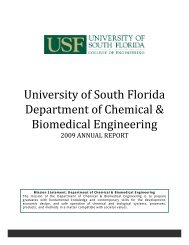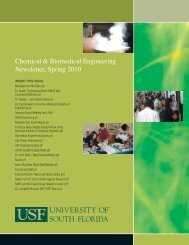2007 - Chemical & Biomedical Engineering - University of South ...
2007 - Chemical & Biomedical Engineering - University of South ...
2007 - Chemical & Biomedical Engineering - University of South ...
You also want an ePaper? Increase the reach of your titles
YUMPU automatically turns print PDFs into web optimized ePapers that Google loves.
Dr. Ryan G. Toomey<br />
Assistant Pr<strong>of</strong>essor<br />
rtoomey@eng.usf.edu<br />
(813) 974-1964<br />
Education:<br />
Post-Doctoral Research, Institute for Microsystems Technology (IMTEK). <strong>University</strong> <strong>of</strong><br />
Freiburg, Germany, 2002-2003<br />
Ph.D in <strong>Chemical</strong> <strong>Engineering</strong>, <strong>University</strong> <strong>of</strong> Minnesota, Minneapolis, 2002<br />
B.S. in <strong>Chemical</strong> <strong>Engineering</strong>, <strong>University</strong> <strong>of</strong> California, Berkeley, 1995<br />
Research Interests: Polymeric Materials, Interfacial Phenomena, Molecular<br />
Recognition, Hydrogels<br />
Smart Polymer Structures for Micr<strong>of</strong>luidics<br />
Our research program is to design and develop micro-scale polymeric<br />
structures that experience changes in shape and other properties when<br />
triggered by an external stimulus. These materials can significantly<br />
advance the capability <strong>of</strong> micr<strong>of</strong>luidics and miniature biosensors, for<br />
they operate without complex circuitry or bulky instrumentation. For<br />
instance, Figure 1 shows a cell sheet on a smart surface. The surface<br />
can either be “turned on” or “turned <strong>of</strong>f” to support or release cells. In<br />
the image, the surface has been turned <strong>of</strong>f and the cell sheet, which<br />
was cultured on the surface, detaches and rolls <strong>of</strong>f. Figure 2 shows E.<br />
Coli. (green) that has been sequestered and pinched <strong>of</strong>f from an<br />
overhead solution using smart polymers (shown in red). These<br />
polymer patterns are currently being explored to separate bacteria<br />
from blood for sample processing in biosensors. This research is highly<br />
collaborative and is carried out in conjunction with Dr. Peter Stroot<br />
(Civil and Environmental <strong>Engineering</strong>, USF) and Dr. Jing Wang<br />
(Electrical <strong>Engineering</strong>, USF).<br />
Recent Publications:<br />
Toomey, R. and Tirrell, M. “Functional<br />
Polymer Brushes in Aqueous Media from<br />
Self-Assembled and Surface-Initiated<br />
Polymers” Annual Review <strong>of</strong> Physical<br />
Chemistry In press (2008).<br />
Vidyasagar, A., Majewski, J., and<br />
Toomey, R. “Temperature induced<br />
volume-phase transitions in surfacetethered<br />
Poly(N-isopropylacrylamide)<br />
networks” Macromolecules (2008).<br />
41:3, p.919-924.<br />
Castellanos, A., DuPont, S., Heim, A.,<br />
Matthews, G., Stroot, P., Moreno, W.,<br />
Toomey, R. “Size-exclusion "capture<br />
and release” separations using surfacepatterned<br />
poly(N-isopropylacrylamide)<br />
hydrogels” Langmuir (<strong>2007</strong>). 23:11, p.<br />
6391-6395.<br />
Alonzo, J., Huang, Z., Liu, M., Mays, J.,<br />
Toomey, R., Dadmun, M., Kilbey S.<br />
“Looped Polymer Brushes Formed by<br />
Self-assembly <strong>of</strong> Poly(2-vinylpyridine)-<br />
polystyrene-poly(2-vinylpyridine)<br />
Triblock Copolymers at the Solid-fluid<br />
Interface. Kinetics <strong>of</strong> Preferential<br />
Adsorption.” Macromolecules (2006)<br />
39:24, p.8434-8439.<br />
Figure 1. Cultured cell sheet released from a smart polymer (poly-Nisopropylacrylamide)<br />
surface. Photo taken by Ophir Ortiz.<br />
The approach is to use stimuli-responsive, polymer films that toggle<br />
the adsorption <strong>of</strong> specific targets in response to a stimulus. The<br />
stimulus could be temperature, pH, or a small analyte, which induces a<br />
change in the surface energy <strong>of</strong> the cross-linked layer. The response<br />
characteristics are built directly into the polymer structure, and<br />
therefore a separateu feedback loop is not required. Ultimately, we<br />
would like to use these materials to exploit subtle differences in the<br />
binding affinities <strong>of</strong> macromolecules and proteins for “bind and release”<br />
separations without having to resort to biological recognition. While<br />
fully natural or biological surfaces impart the highest level <strong>of</strong><br />
specificity, they also lack stability in non-native environments. Our<br />
goal is to bring a level <strong>of</strong> recognition to responsive synthetic materials.<br />
In our current work, we addressing two main points:<br />
Figure 1. E. Coli. (green) sequestered<br />
between smart polymer monoliths<br />
(red).Photo by Samuel DuPont.<br />
18





